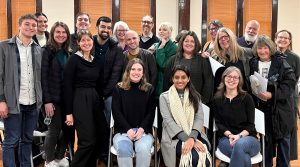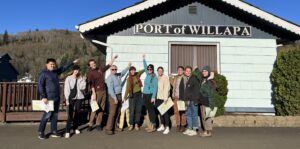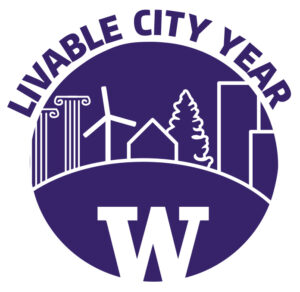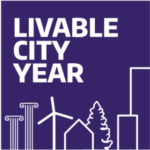Pacific County 2022–2025
This partnership is the beginning of a multiyear relationship that will link UW students and faculty with projects that advance PCEDC’s livability, economic development, and housing goals for Pacific County.

Master of Urban Planning students attended a community event in South Bend, Washington in January 2023.
Launch event featured in The Chinook Observer
Inventory of Properties in Need
PCEDC Project Leads: Susan Yirku and Kelly Rupp
Faculty: Katie F. Cote and Jess Zimbabwe
UW Department: Community, Environment and Planning
Quarter: Fall 2022
Pacific County is particularly challenged to provide a range of affordable housing choices. The demand for housing is increasing both as the county’s resident population grows and wage/income disparity fails to keep up with housing costs. Workforce housing is an increasing concern for area businesses, as are housing and services needs for an aging population and those with special needs or family situational issues. The attraction of Pacific County as a vacation destination both for short-term holiday renters and vacation home buyers further pressures the availability of affordable housing options by reducing housing stock which could otherwise support long-term residential tenants.

Community, Environment, and Planning seniors visited Pacific County in Autumn Quarter 2022.
One strategy for increasing the housing stock across Pacific County to meet demand from low- to middle-income buyers and renters is to refurbish, replace, or re-purpose existing residential properties that are abandoned, foreclosed, in need of repair or rehabilitation, or only used seasonally. The county has significant numbers of homes that over 50 years old and whose maintenance has not kept up with the region’s harsh climate. In particular, mobile homes – although relatively inexpensive – are notoriously unsuited for Northwest climates. Many of Pacific County’s 2,700 mobile homes are believed to be in need of significant maintenance if not outright condemnation. Identifying properties in need of refurbishment or deserving of replacement is a fast-path to opportunities for investment in new and quality housing on these sites.
Objectives of this exercise include a parcel-identified database of vacant/abandoned/repairs-needed/tax-arrears/ordinance-infringing residential properties in each of four municipalities (Long Beach, Ilwaco, South Bend, Raymond) and in unincorporated Pacific County.
Middle-income-friendly Housing Ordinances from Municipalities and County
PCEDC Project Leads: Susan Yirku and Kelly Rupp
Faculty: Katie F. Cote and Jess Zimbabwe
UW Department: Community, Environment and Planning
Quarter: Fall 2022
Building codes and zoning ordinances imposed by municipalities and county can
significantly influence development construction costs. The time and fees required for permitting and plan reviews may lead to increased financing costs, delayed construction starts, and unforeseen fees for permits and inspections. Regulatory predictability, consistency, and flexibility in oversight processes will contribute to private sector willingness to invest in affordable housing. All municipalities and county include goals to review and amend any development regulations that unnecessarily add to housing costs, development time, or otherwise constrain innovative housing solutions.
This project will assess city and county development ordinances related to housing, specifically those impacting density (multi-family dwellings), affordability, and zoning, including: zoning, permitting, use, ADUs, short-term rentals, developer incentives, development fees, and developer constraints. It will compare ordinances across jurisdictions (municipalities of Long Beach, Ilwaco, South Bend, and Raymond, plus Pacific County). In addition, it will compare these statutes with progressive jurisdictions (relative to affordable/attainable housing).
Housing Ordinance Case Studies and Analysis
PCEDC Project Leads: Susan Yirku and Kelly Rupp
Faculty: Arthur Acolin
UW Department: Runstad Department of Real Estate
Quarter: Spring 2023
Referencing the PC02 catalog of development ordinances, this project will assess consistency and equivalency across jurisdictions (municipalities of Long Beach, Ilwaco, South Bend, and Raymond, plus unincorporated Pacific County). In addition, it will compare these statutes with progressive jurisdictions (relative to affordable/attainable housing). It will analyze ordinance language and planning/permitting processes to suggest where development is being discouraged and where changes or amendments might better encourage middle housing development.
Interviews with municipal and county planners/permitters are encouraged to ensure comprehensive examination of formal and informal processes for building plans, permits, and licenses.
Convene workshops with county and city planning commissions to propose increased densities for housing within residential zones (ADUs, multi-plex densities), pre-approved housing plans for small units, consistent policies or ordinances county-wide for short-term rentals, priorities to include middle-income senior housing).
Explore UGA amendment and/or areas swap per new GMA statute
PCEDC Project Leads: Susan Yirku and Kelly Rupp
Faculty: Katie Cote
UW Department: Urban Design and Planning
Quarter: Spring 2023
The recently-passed SB5593 enacts changes the Growth Management Act (GMA) to adjust an urban growth area to include new adjacent areas that are more appropriate for development while removing an equivalently-sized area less desirable for development (RCW 36.70A.110). The appeal of added land areas within municipal UGAs (supported by municipal water, sewer, transportation, and utilities infrastructure) is significant relative to zoning densities for new housing, potentially creating new lots for development or conversion of existing properties zoning towards increased densities or development flexibility.
Four municipal UGAs (Long Beach, Ilwaco, South Bend, and Raymond) and one county UGA (Seaview) are to be examined to propose additions/subtractions.
Ground-truthing (i.e., site visits) should be recommended and/or advice/suggestions from planners from each municipality to qualify proposed additions/subtractions. Digital GIS maps for all proposals are desired.
Land Capacity Analysis
PCEDC Project Leads: Susan Yirku and Kelly Rupp
Faculty: Branden Born (Wi) and Katie Cote (Sp)
UW Department: Urban Design and Planning
Quarter: Winter and Spring 2023
A “Housing Needs Assessment” (HNA) includes a “Land Capacity Analysis” (LCA) as a necessary component. The Land Capacity Analysis is a methodology conducted by counties and cities to determine the amount of vacant, partially used, and under-utilized lands, as well as the redevelopment potential of built properties, to accommodate growth. This process identifies the potential for land within a community’s boundaries to accommodate anticipated housing growth, given its current zoning restrictions. Analysis is typically conducted with Geographic Information System (GIS) and should consider capacity by housing type: single family, 2-3-4-plex, and multifamily units. Counties and cities use a LCA to determine if the existing Urban Growth Areas (UGAs) can accommodate twenty years of urban growth.
Housing Needs Assessment
PCEDC Project Leads: Susan Yirku and Kelly Rupp
Faculty: Branden Born (Wi) and Katie Cote (Sp)
UW Department: Urban Design and Planning
Quarter: Winter and Spring 2023
A “Housing Needs Assessment” (HNA) is a study to identify future housing needs to serve all economic segments of the community. Cities and counties planning under Washington State’s Growth Management Act (GMA) must conduct the assessment as part of their comprehensive plan updates. Pacific County municipalities (Long Beach, Ilwaco, South Bend, and Raymond) and the county itself completed their most recent Comprehensive Plan updates prior to the covid-19 pandemic and are unreflective of the pandemic-linked surge in home prices and rents. Pressures on affordable housing availability in Pacific County are compounded by its historical popularity as an ocean-side tourist destination with significant demand for vacation and seasonal homes. The pandemic further compounded the shortage of affordable housing as remote workers from across the country were attracted by relatively inexpensive housing compared to larger metropolitan areas.
U.S. Census historical data likely lags the recent 2020-2022 price increases and
population growth pressures experienced throughout the county. Insights into current housing availability and affordability are being sought with this HNA exercise.
Willapa Bay Ferry Feasibility
PCEDC Project Leads: Susan Yirku and Kelly Rupp
Faculty: Russell Walker and Samantha Buhr
UW Department: Foster School of Business
Quarter: Winter 2024
A pedestrian and bike ferry to connect the Port of Peninsula in Nahcotta with the Tokeland Marina (and possibly Bay Center or South Bend) would complete a round-the-county tourism trail. Such a ferry business has been broadly supported by the community, but no formal feasibility study has documented its merits, risks, nor financial modeling. A proforma business plan needs be developed to detail breakeven scenarios of a successful small capacity boat service able to commercially operate between ports. Seasonal and year-round scheduling should be considered. The plan should outline operating costs (fuel, staff, maintenance), overhead (insurance, licensing, inspections), marketing and sales operations (online and in-person ticketing capacity, tourism bureau and tribal promotion linkage), and staff needs (roles, qualifications, necessary certifications/licensing). Comparable examples of tourist ferry operations should be identified and researched for best practices or cautionary lessons. Operating risks and liability concerns should be identified. Necessary WA State, Army Corps, and other regulatory authorities expected to provide oversight to the operation should be noted.
Read the article in the Chinook Observer
Infill Housing Plan
PCEDC Project Leads: Susan Yirku and Kelly Rupp
Faculty: Gareth Roe
UW Department: UW Tacoma Urban Studies
Quarter: Winter 2024
Build upon housing project data already collected by LCY teams (PC01, PC02, PC03, PC05, PC06) to create recommendations for how each PacCo municipality (South Bend, Raymond, Long Beach, Ilwaco) and unincorporated county areas can meet projected needed for dwelling units in 2044 (twenty-year horizon) per Commerce Dept’s “Housing for All Planning Tool” (HAPT, see Appendix A below) under RCW 36.70A.030. For each jurisdiction, apply current zoning ordinances and permitting requirements to determine where sufficient new dwelling units can be developed (parcels that are vacant, surplus, derelict, for-sale, etc) to meet HAPT projections. Reference Land Capacity Analysis and Housing Needs Assessment (PC05, PC06) project maps and Case Studies (PC03). If sufficient housing cannot be achieved under current zoning/permitting constraints, recommend how changes in zoning/permitting or amendments to Comprehensive Plans would yield satisfactory results. Consult with area architects to consider affordability (i.e., housing types and sizes that will be affordable to particular HAPT income thresholds, pre-approved building plans for smaller house types, ADUs, or duplex/triplex/quadplex structures).
Property Inventory Visualization & Map Refresh
PCEDC Project Leads: Susan Yirku and Kelly Rupp
Faculty: Jeff Barland
UW Department: Information School
Quarter: Winter 2024 and Summer 2024
Build upon the “available property” inventory database created in PC02 and the Data Sciences club exercise (Spring 2023, UW-Tacoma AI Club) to deliver a visual map of potentially developable property parcels for housing across the county, with particular focus on these 11 communities: Long Beach (municipality), Ilwaco (municipality), South Bend (municipality), Raymond (municipality), Ocean Park area, Seaview, Chinook, Naselle, Bay Center, Tokeland/North Cove, Menlo, and Unincorporated Pacific County. The visualization tool should be built upon readily available software (ideally, open-source without fees/restrictions, or alternatively, available commercially without undue licensing fees without requiring extensive training or operating expertise). Include documentation detailing user instructions and any necessary maintenance.
Additionally, develop a methodology whereby the underlying database supporting the property inventory can be updated. That is, can existing databases with county-wide parcel information and/or real estate listings be mined semi-automatically on some periodic basis (monthly, quarterly) to update the foundation data from which the visualization maps are based? If updates cannot possibly be fully push-button, then prescribe what manual intervention and/or data uploads are required.
View the Winter final presentation
View the Summer final presentation
EV Charging Station Needs Assessment and Idealized Mapping
PCEDC Project Leads: Susan Yirku and Kelly Rupp
Faculty: Keith Harris (Wi) and Katherine Nesse (Sp)
UW Department: Urban Design and Planning
Quarter: Winter and Spring 2024
Electric vehicle charging infrastructure must be rapidly developed over the next decade to ensure satisfactory capacity for expected needs by both residents of Pacific County and visitors. Seasonal tourism to the county (especially to the Long Beach Peninsula for fishing, clamming, fireworks, kite flying, sports tournaments, miscellaneous festivals) attracts tens of thousands of visitors on any given weekend. Charging stations for electric vehicles for both residents and these regular visitor swells must be available both at public venues (state, county, city parks, parking areas near coastal attractions, industrial ports, libraries, schools, medical facilities) and private commercial establishments (lodging, retail, dining, as well as places of employment). With this project, propose where (ideally) locations for fast-charging (Level II or III) stations can/should be sited.
Propose a ten-year phase-in of construction. Consider if other jurisdictions across the U.S. (particularly those rural areas where seasonal tourism will create significant needs) provide a guide, planning process, or best practices that might be leveraged in Pacific County. Document assumptions (number of vehicles needing electric charging, resident needs, tourist needs, average charging time). Clearly and proportionately assess numbers and placement of charging stations at public sites (especially tourism focused) and private locations (largely hospitality businesses catering to visitors). Discussion with local municipal planners and federal/state/county public sites (parks, libraries, schools, hospitals, etc) is expected as part of this exercise, to ensure consideration of local plans (perhaps already-in-process considerations), current zoning ordinances, and planned development.
Read the article in the Chinook Observer
South Bend Waterfront Revitalization Plan
PCEDC Project Leads: Susan Yirku and Kelly Rupp
Faculty: Keith Harris (Wi) and David Blum (Sp)
UW Department: Urban Design and Planning
Quarter: Winter and Spring 2024
Envision a master plan for development of commercial properties and public access along South Bend’s Willapa River frontage extending from the South Bend Boat building to the Willapa Hills Trailhead at Summit Avenue in Raymond. A requisite goal is to extend the terminus of the Willapa Hills State Park Trail (currently ending/beginning at Summit Avenue) into downtown South Bend (past the South Bend Boat operation). Expanding the Trail with public spaces is an objective, helping energize downtown South Bend and provide safe pedestrian access for the community.
This waterfront extent includes parcels that are privately and publicly-owned (by South Bend, Pacific County, and the Port of Willapa Harbor). The Master Plan should consider ownership easements required, auto- and pedestrian-circulation around trail areas, and provision of utilities (electrical power, water, sewer). Sea-level rise over future decades should be reflected in recommendations and concerns.Renderings of proposed new trail or road/structure construction would be valued. Issues and constraints, including environmental cleanup or permitting requirements within the waterfront area (within the Shoreline Management Plans of South Bend and Pacific County). Multiple project phases should be proposed, including a future phase where a Willapa Bay “ferry” dock is established.
Downtown Raymond Revitalization
PCEDC Project Leads: Susan Yirku and Kelly Rupp
Faculty: Jess Blanch and Jess Zimbabwe (Au), Keith Harris (Wi), Richard Sepler (Sp)
UW Department: Community, Environment and Planning, Urban Design and Planning
Quarter: Fall 2024 – Spring 2025
This project will focus on a plan for downtown Raymond’s revitalization, emphasizing infrastructure improvements and economic development for “Main Street,” and considering a “creative district” attraction/development. Undergraduate Community, Environment, and Planning (CEP) students will interview Raymond stakeholders (city staff, council, and community leaders), and produce a final report summarizing their findings, relevant case studies, analysis, and recommendations.
As part of the graduate Urban Planning studio (MUP), students will also assist the City of Raymond (Pacific County) in developing an implementable downtown revitalization plan and demonstration project plan. This project will focus on the preparation of initial research (Initial Conditions Report – ICR) that summarises the regulatory context, the facilitation of community involvement and the preparation of a detailed strategy plan to support the revitalization of Raymond downtown. This plan will emphasize infrastructure improvements and economic development for “Main Street” and consider a “creative district” attraction/development.
View the CEP final presentation
Read the MUP Winter final report
View the MUP Winter final presentation
Read the MUP Spring final report
View the MUP Spring final presentation
Marine Services Sector Cluster
PCEDC Project Leads: Susan Yirku and Kelly Rupp
Faculty: Jess Blanch and Jess Zimbabwe (Au), Keith Harris (Wi), David Blum (Sp)
UW Department: Community, Environment and Planning, Urban Design and Planning
Quarter: Fall 2024 – Spring 2025
Pacific County Economic Development Council is working to create a plan for an “industry cluster” of business and educational resources that specifically addresses their growing marine services sector. This cluster would bring together marine and maritime-dependent businesses, innovators, and educators for local sourcing of expertise necessary to support modern vessel maintenance and operations.
Undergraduate Community, Environment, and Planning (CEP) students will focus on Port of Willapa Harbor properties (South Bend Boat, Nettleson’s building, Bendiksen’s Landing, Tokeland Marina, South Fork lands and wharf, Raymond dock) where a regional “hub” of marine services could be centered. The plan will also explore collaboration with Grays Harbor College, local Raymond and South Bend High Schools, UW Washington Sea Grant for marine services education and job development programs, and regional coastal counties for RISE grant funding (US Economic Development Agency).
As part of the graduate Urban Planning studio (MUP), students will produce a sustainable and achievable development blueprint for a marine services industry in Pacific County that focuses on expanding maintenance services for vessels that are primarily bound to Willapa Bay. In Winter, planning students will perform a market study of the current marine services ecosystem in Pacific County in order to understand the local market for marine services, from the perspectives of various local stakeholders. The goal will be to identify successful models that have been implemented elsewhere in coastal Washington and Oregon to support marine services. In spring students will focus on understanding how the redevelopment of vacant industrial lands in rural Washington State can be successfully planned and implemented to support local employment and economic development. The project will focus on assembling this information into a set of alternatives that will be presented to the PCEDC on housing development, entitlements and scheduling such as all relevant Federal, state and city permitting requirements, environmental constraints, and draft critical path schedule illustrating pre-development tasks. The project will produce a draft site plan to include in-water and uplands development opportunities.
View the CEP final presentation
Read the MUP Spring final report
Long Beach Convention Center
PCEDC Project Leads: Susan Yirku and Kelly Rupp
Faculty: Samantha Buhr and Russell Walker
UW Department: Foster School of Business
Quarter: Winter 2025
Pacific County Economic Development Council’s interest in a conference center for Long Beach has been nurtured for many years. The convention center presents an opportunity to grow tourism revenues through group travel for meetings, conferences, education events, and other programs that can be highly valued. The appeal of such visitor traffic is especially compelling for the less popular months for Pacific County tourism – the so-called “shoulder season” months of October through April. The student report and presentation materials will synthesize interviews, comparable convention center case studies, phased plans for development, initial and sustained financial investment, necessary community-wide supporting business and labor infrastructure, expected marketing and promotion plan, and operating staff roles.
Infill Housing Plan Continuation
PCEDC Project Leads: Susan Yirku and Kelly Rupp
Faculty: Katie F. Cote
UW Department: Internship Winter 2025 and Spring 2025
Quarter: Spring 2025
Build on the work started in Spring 2024 to analyze land conditions, regulatory controls, and market factors influencing in-fill development and seeking recommendations on how to increase in-fill housing development. This project develops recommendations for increasing in-fill housing specific to each municipality with a particualar focus on Raymond, South Bend, Long Beach and Ilwaco that considers local conditions, preferences, and development codes. Ensure the quality of analysis and recommendations is consistent among the four municipalities and includes visuals that can be used for public engagement and outreach.
Read the final report for Raymond
Read the final report for South Bend
Read the final report for Long Beach
Read the final report for Ilwaco
Infill Housing Plan Continuation
PCEDC Project Leads: Susan Yirku and Kelly Rupp
Faculty: Arthur Acolin
UW Department: Runstad Department of Real Estate
Quarter: Spring 2025
This project through three case studies aims to inform the work of student groups working with Katie Cote on proposals to support increased production of infill development in Pacific County (cities and incorporated county). The jurisdictions for this project include South Bend, Raymond, Long Beach, and Ilwaco. The overall objective is to acquaint Pacific County municipalities with examples of where infill housing has been successfully impacted and provide guidance (and reminders of legislated statutes) for revisions to processes, zoning, etc. where appropriate. This project will identify potential actions that might encourage infill housing development in Pacific County (inclusive of ADUs). The case studies will focus on ideas/inspiration/best practices from “like” municipalities (e.g., coastal, tourist-intensive, 2nd homes and vacation home pressures, rural environment). The case studies will focus on the aspects of potential expansion of developable land within Urban Growth Area (UGA) and understand what incentives are effective/impactful for developers to produce workforce and/or affordable housing. The case studies will examine examples of successful land subdivision/lot splitting in rural environments where sewage and city water is unavailable and potential for allowing coliving in those areas as well. Finally, the case studies will also investigate successes and challenges to developing modular construction, especially in coastal regions where conditions may require more robust building standards.
View the UGA final presentation
View the Housing final presentation
Read the Workforce Housing final report
View the Workforce Housing final presentation
Alternative Business Uses for Cannabis Growing Facilities
PCEDC Project Leads: Susan Yirku and Kelly Rupp
Faculty: Samantha Buhr
UW Department: Foster School of Business
Quarter: Spring 2025
The Port of Willapa Harbor hosts numerous businesses dedicated to growing cannabis indoors. The economics for cannabis production and value-added products continues to evolve as additional states pursue legalization and changes are proposed for federal restrictions on banking services and controlled substance use. Existing tenants of the Port who grow cannabis and/or prepare/distribute cannabis-based products muse about converting these facilities to support other specialty agriculture or horticultural crops, or re-purposing the buildings to other uses where the infrastructure buildout provides a logical foundation. The Pacific County Economic Development Council believes research into possible alternative uses for these facilities is needed. Students will create an inventory to assess the capacities and capabilities of every cannabis grow building in the Port’s ownership, and research other industry groups that require similar or adjacent environmental controls and/or utilities capacities. A report will summarize their findings and analysis and suggest business alternatives that significantly leverage existing infrastructure.
An FPHS-Based Health Equity Evaluation for Pacific County Health and Human Services
PCEDC Project Leads/Site Supervisor: Gracie Minks
Faculty: Eyob Mazengia and Dylan Stevenson
UW Department: School of Public Health and the College of Built Environments,
Quarter: Spring 2025
Pacific County Health and Human Services (PCHHS) partnered with the University of Washington School of Public Health and College of Built Environments to conduct a capstone thesis project evaluating how the department implements Washington State’s Foundational Public Health Services (FPHS) framework. This evaluation, led by a Master of Public Health and Urban Planning student, assessed internal capacity, identified system gaps, and developed strategic recommendations to improve the use of FPHS funding in a rural context and advance health equity.




